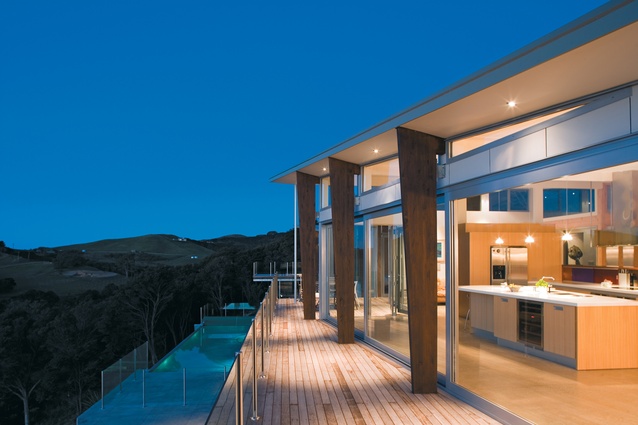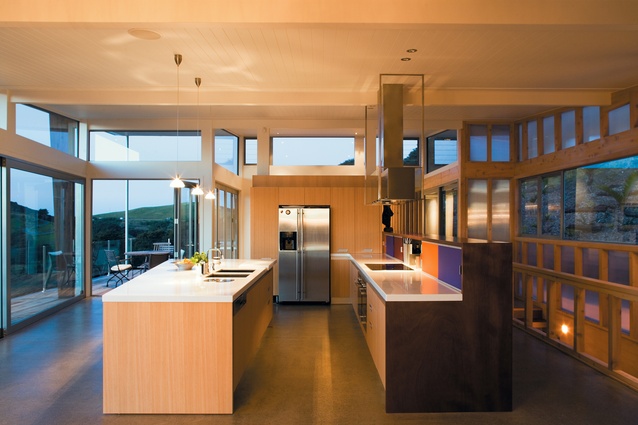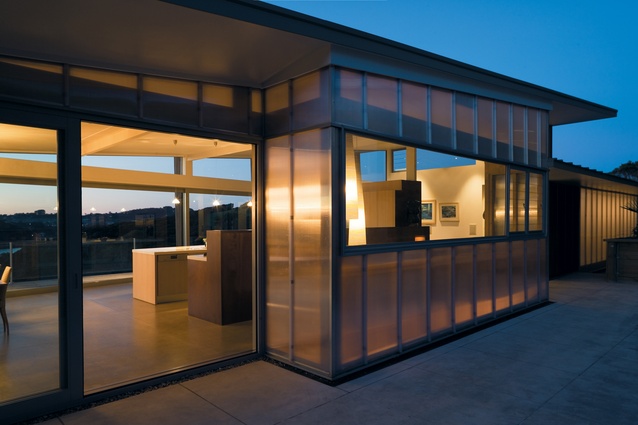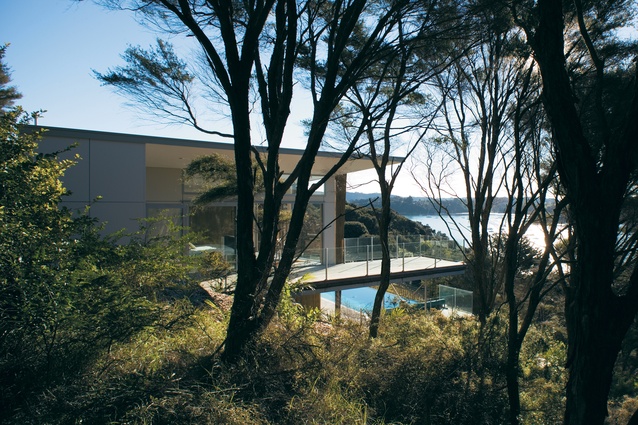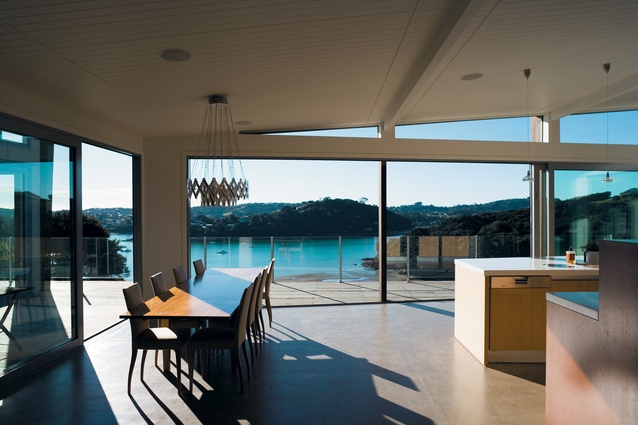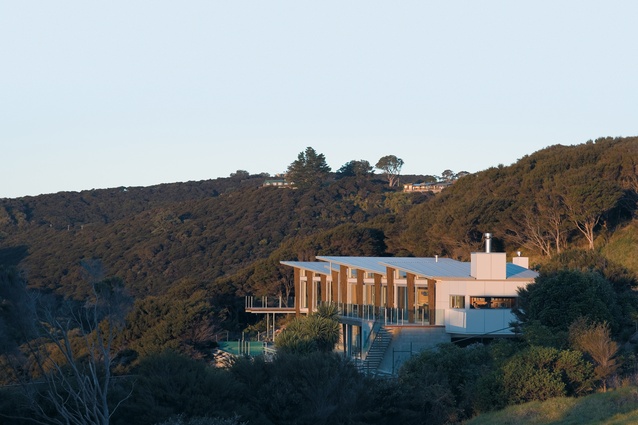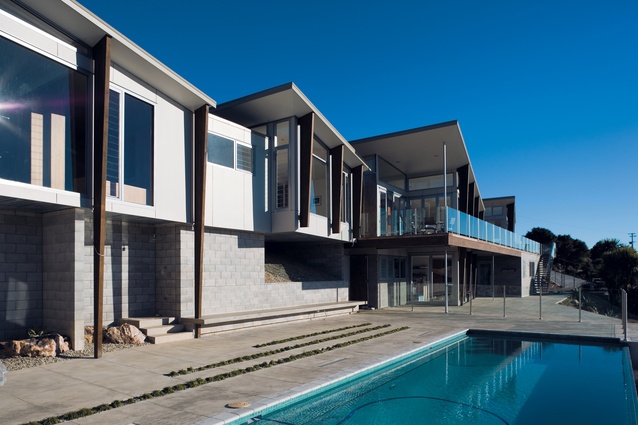Houses Revisited: Island adventure
From 2006: London is not an easy city to leave, but one family decided on a new start, in a new place, in a new house. Now they live on a hill above a Waiheke bay in a contemporary home designed by Geoff Richards.
No matter what time you catch a Waiheke ferry to or from New Zealand it’s beer o’clock for at least a few of the passengers. There they stand, up by the café counter, in jeans, jandals and old woolly jerseys, clutching bottles of Tui and swaying gently as the boat surges across the Gulf. They rarely disturb the other passengers, who eke out the Herald, glance over the real estate flyers, and sip the slush sold as coffee. Only in their pungency are they assertive, these wild-haired women and unshaven men. Like the mist-dwelling Ur-men who briefly appear in Tolkein’s Lord of the Rings, they seem to know they belong to a diminishing breed. For these Old Waihekeans – duckers and divers and artful dodgers – the game’s almost up. The island is entering the age of the über-menschen.
It’s a wonder it has taken so long. Only infra-structural inadequacies – principally the lack of an efficient ferry service – can explain Waiheke’s traditional status as a dozy retreat for low- or no-earners. That, and the inability of other Aucklanders to figure out a way to make island life work. (Or rather, how they could work if they lived on the island.) Today, neither condition applies. Faster and more frequent ferries constitute a commuter service, and alongside a growing population of nine-to-fivers Waiheke now accommodates increasing numbers of people with either the means or skills to transcend the island’s logistical limitations.
The penny has well and truly dropped: by taking a 35 minute trip from the Auckland CBD you can swap motorway crawls and banal suburbia for safe beaches, Gulf vistas and a benign micro-climate – and you can keep your job. (In fact, given the escalating price of island real estate, you’ll probably need a better one.)
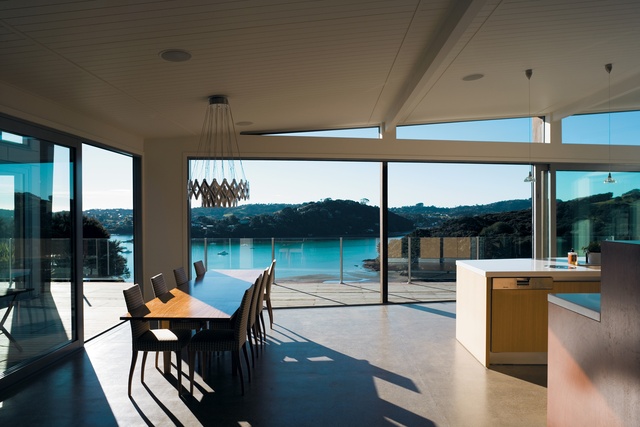
While Aucklanders may have been slow to fully appreciate Waiheke, visitors from bigger, harder places tend to get it immediately. The owners of this new house above a bay on the south side of the island first saw the site a few days before the end of a holiday visit in 2002. They had seen a ‘For sale’ sign and went to have a look. It was a beautiful day, the couple’s young sons played on the quiet beach beneath the steeply-sloping section, partially planted in vines, but mostly covered in bush … By the time they got on the plane back to London they had committed to buy the property.
The new owners don’t do things by halves. Not only did they leave successful careers and full lives lived in an attractive corner of one of the world’s great cities and move to an island off an island on the other side of the world, they decided they would have an architectural adventure. Part of the attraction of the move to Waiheke, the owners say, was that it offered an opportunity all but non-existent back home: “You just don’t build a new house in England.”
Unfamiliarity with local construction practices or traditions, let alone the Auckland architectural scene, was no deterrent. The owners asked around their few local contacts, drew up a list of half a dozen architecture practices and, from London, sent them a one-page brief with a request for a response. Three practices responded (the others, you’d think, might be regretting their lack of interest), and the owners arranged to meet them on site. Following a later recommendation, Geoff Richards was added to the short-list of practices, and he was the architect the owners eventually chose. All of the short-listed practices may have come up with good designs, the owners acknowledge, but “Geoff was the one who asked the most interesting questions”.
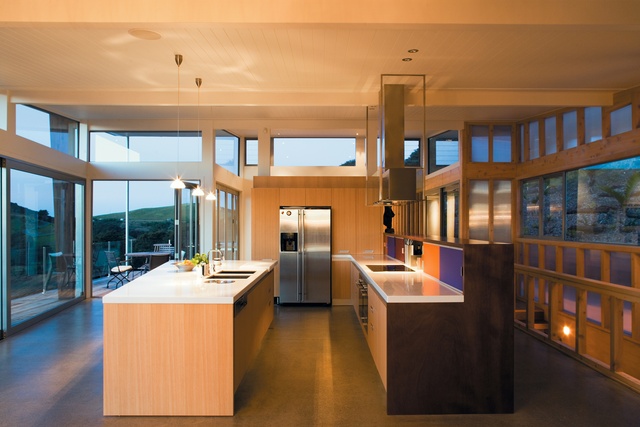
Having opted to build a new house, the owners wanted a new house – that is, a piece of contemporary residential architecture. They specified the use of the classic modernist palette of steel, concrete, glass and wood – “we like modern materials”. There were various functional requirements: separation of the adults’ and children’s sleeping areas, provision of office space and guest bedroom, generous kitchen and laundry areas, a good-sized garage, and a workroom. And, obviously, the owners wished to enjoy the views of the bay and of green hills available from a site on the side of a north-facing hill. (Which they can do, in this house: “It’s very good for our souls to look out at all this.”
A key design question was whether the house should traverse the sloping site, or descend with it. Owners and architect agreed that the house should be arranged horizontally along its east-west axis. “In London, we lived in a vertical stack,” one of the owners says. “We didn’t want to do that here.” Geoff Richards says the house “could have been organized to spill down the site, but we decided to keep it simple with two levels”. In this house, a long plan does not equal an extruded box. The upper level is effectively broken up into four pavilions, staggered or stepped back so that each is not restricted to a flat view to the north, and each receives sunlight through the course of the day. The effect, Geoff Richards says, is of “a flower opening in the morning”. Even more light is brought into the house through the clerestory windows under the sloping roofs rising to the east.
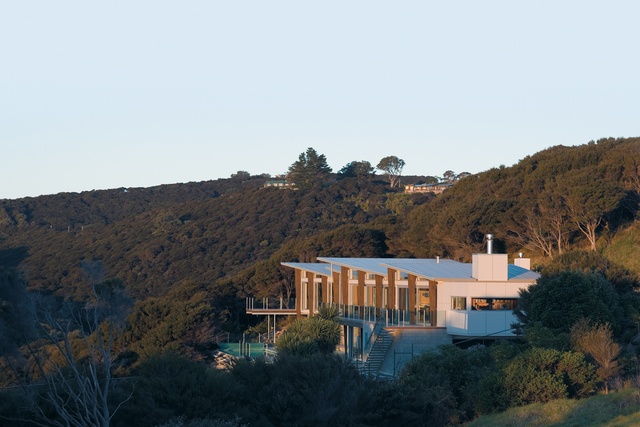
The light- and view-winning strategies pursued on the north side, together with the narrowness of the house – it is basically one room and a passageway wide – make possible a very different treatment on the south side of the house, which faces against the slope. While on the north side, especially at its upper level, transparency is all, the south side is more about translucency. Total transparency would have been too much of a good thing on this site, which is quite exposed. It’s not just that there isn’t so much to see from the backside of the house; it’s also that a house – even a pavilion house – should provide shelter as well as views. On this rear elevation the architect has deployed sheets of acrylic cladding (Danpalon) with the insulating properties of double-glazing, tacked to exposed macrocarpa framing. In contrast to the front elevation, with its highly processed materials, the rear has a somewhat deconstructed appearance. A nod to Old Waiheke, perhaps?
The owners were closely involved in the building of their new house. For two years they lived in the small existing house on the site, and they project-managed construction. “Things evolved a bit” in the course of the job – for example, the swimming pool was re-sited from the centre of the lower-level terrace to the east end – but the attention to detail and commitment of architect, tradesmen and clients does not seem to have wavered. It’s a big decision, to start out all over again in a new country; in this case, fortune has favoured the brave.
Click here to see more Houses Revisited. And sign up to our email newsletters to receive Houses Revisited straight to your inbox.
Note: These are stories from our archives and, since the time of writing, some details may have changed including names, personnel of specific firms, registration status, etc.

